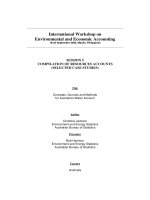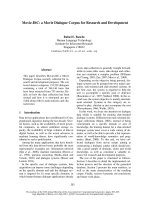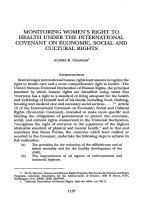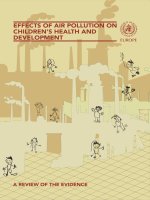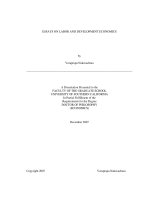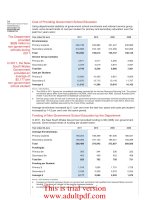Draft International Covenant on Environment and Development potx
Bạn đang xem bản rút gọn của tài liệu. Xem và tải ngay bản đầy đủ của tài liệu tại đây (1.46 MB, 242 trang )
Draft
International Covenant on
Environment and Development
Fourth Edition: Updated Text
Environmental Policy and Law Paper No. 31 Rev. 3
Draft International Covenant on Environment and Development Fourth Edition
• LaunchedattheUNCongressonPublicInternatio-
nal Law on 13 March 1995
• SecondeditionpresentedtotheUNMemberStates
attheclosingoftheUNDecadeonInternational
Law, 54
th
UN/GA
• ThirdeditionpresentedtotheUNMemberStatesat
the 59
th
UN/GA
• FourtheditionconveyedtotheUNMemberStateson
occasionoftheHigh-levelEventonBiodiversityon
22September2010duringthe65
th
UN/GA
IUCNEnvironmentalLawProgramme
Environmental Law Centre
GodesbergerAllee108-112
53175Bonn,Germany
Tel.:++49228-2692231
Fax:++49228-2692250
www.iucn.org/law
International Council of Environmental Law (ICEL)
–towardsustainabledevelopment–
Postfach120369
53045Bonn,Germany
Tel.:++49228-2692228
Fax:++49228-2692251
www.i-c-e-l.org
ICEL
TheEnvironmentalLawProgrammeoftheInternational Union for the
ConservationofNatureandNaturalResources
in cooperation with
The International Council of Environmental Law
–towardsustainabledevelopment–
ICEL
Draft
International Covenant on
Environment and Development
Fourth Edition: Updated Text
Draft
International Covenant on
Environment and Development
Fourth Edition: Updated Text
The Environmental Law Programme of the International Union for
the Conservation of Nature and Natural Resources
in cooperation with
The International Council of Environmental Law
– toward sustainable development –
Environmental Policy and Law Paper No. 31 Rev. 3
The designation of geographical entities in this book, and the presentation of the material, do not imply the
expression of any opinion whatsoever on the part of IUCN or ICEL concerning the legal status of any country,
territory, or area, or of its authorities, or concerning the delimitation of its frontiers and boundaries.
The views expressed in this publication do not necessarily reect those of IUCN or ICEL.
The preparation and publication of the fourth edition of the Covenant was a project of the Elizabeth Haub
Foundations for Environmental Policy and Law (Canada, USA, Germany).
Published by: IUCN, Gland, Switzerland
IUCN Environmental Law Programme, Bonn, Germany
International Council of Environmental Law (ICEL), Bonn, Germany
Copyright: © 1995, 2000, 2004, 2010 International Union for Conservation of Nature and
Natural Resources
First published 1995
Second edition 2000
Third edition 2004
Fourth edition 2010
Reproduction of this publication for educational or other non-commercial
purposes is authorised without prior permission from the copyright holder
provided the source is fully acknowledged.
Reproduction for resale or other commercial purposes is prohibited without
the prior written permission of the copyright holder.
Citation: IUCN Environmental Law Programme (2010). Draft International
Cove nant on Environment and Development. Fourth edition: Updated Text.
Prepared in cooperation with the International Council of Environmental Law.
Gland, Switzerland: IUCN. xxxii + 206 pp.
ISBN: 978-2-8317-1286-4 4
th
edition
2-8317-0764-1 3
rd
edition
2-8317-0524-X 2
nd
edition
2-8317-0288-7 1
st
edition
Layout by: Barbara Weiner, Desktop Publications Co-ordinator
Printed by: medienHaus Plump GmbH, Rheinbreitbach
Available from: IUCN Publications Services
International Council of Environmental Law (ICEL)
Rue Mauverney 28 Postfach 12 03 69
1196 Gland 53045 Bonn
Switzerland Germany
Tel.: ++ 41 22 999 0000 Tel.: ++ 49 228-2692228
Fax: ++ 41 22 999 0010 Fax: ++ 49 228-2692251
www.iucn.org/publications www.i-c-e-l.org
A cataloque of IUCN publications is also available.
The text of this book is printed on Offset 100 g/m
2
paper.
ICEL
v
TABLE OF CONTENTS
Foreword to the fourth edition xi
Foreword to the third edition xiii
Foreword to the second edition xv
Foreword to the rst edition xvii
Contributors xxv
Table of Abbreviations xxix
PREAMBLE 1
Commentary 27
Part I. OBJECTIVE 2
ARTICLE 1: OBJECTIVE 2
Commentary 34
Part II. FUNDAMENTAL PRINCIPLES 2
Commentary 38
ARTICLE 2: RESPECT FOR ALL LIFE FORMS 2
Commentary 38
ARTICLE 3: COMMON CONCERN OF HUMANITY 3
Commentary 39
ARTICLE 4: INTERDEPENDENT VALUES 3
Commentary 41
ARTICLE 5: EQUITY AND JUSTICE 3
Commentary 43
ARTICLE 6: PREVENTION 3
Commentary 45
ARTICLE 7: PRECAUTION 3
Commentary 49
ARTICLE 8: PROPORTIONALITY 3
Commentary 51
ARTICLE 9: RESILIENCE 4
Commentary 52
ARTICLE 10: RIGHT TO DEVELOPMENT 4
Commentary 52
ARTICLE 11: ERADICATION OF POVERTY 4
Commentary 53
ARTICLE 12: COMMON BUT DIFFERENTIATED RESPONSIBILITIES 4
Commentary 54
vi
III. GENERAL OBLIGATIONS 4
Commentary 55
ARTICLE 13: STATES 4
Commentary 55
ARTICLE 14: PHYSICAL AND LEGAL PERSONS 5
Commentary 58
ARTICLE 15: INDIGENOUS PEOPLES 5
Commentary 65
ARTICLE 16: INTEGRATED POLICIES 5
Commentary 67
ARTICLE 17: TRANSFER OR TRANSFORMATION OF ENVIRONMENTAL HARM 6
Commentary 69
ARTICLE 18: EMERGENCIES 6
Commentary 72
Part IV. OBLIGATIONS RELATING TO NATURAL SYSTEMS AND
RESOURCES 6
Commentary 74
ARTICLE 19: STRATOSPHERIC OZONE 6
Commentary 74
ARTICLE 20: GLOBAL CLIMATE 7
Commentary 76
ARTICLE 21: SOIL 7
Commentary 77
ARTICLE 22: WATER 7
Commentary 79
ARTICLE 23: ECOSYSTEM SERVICES 7
Commentary 83
ARTICLE 24: ECOSYSTEM APPROACH 8
Commentary 85
ARTICLE 25: BIOLOGICAL DIVERSITY 8
Commentary 86
ARTICLE 26: CULTURAL AND NATURAL HERITAGE 9
Commentary 90
vii
Part V. OBLIGATIONS RELATING TO PROCESSES AND ACTIVITIES 9
Commentary 91
ARTICLE 27: PREVENTION OF HARM 9
Commentary 92
ARTICLE 28: POLLUTION 9
Commentary 93
ARTICLE 29: WASTE 9
Commentary 95
ARTICLE 30: INTRODUCTION OF ALIEN OR MODIFIED ORGANISMS 10
Commentary 97
Part VI. OBLIGATIONS RELATING TO GLOBAL ISSUES 10
Commentary 100
ARTICLE 31: ACTION TO ERADICATE POVERTY 10
Commentary 100
ARTICLE 32: CONSUMPTION AND PRODUCTION PATTERNS 11
Commentary 101
ARTICLE 33: DEMOGRAPHIC POLICIES 11
Commentary 103
ARTICLE 34: TRADE AND ENVIRONMENT 12
Commentary 104
ARTICLE 35: TRANSNATIONAL ECONOMIC ACTIVITIES 13
Commentary 109
ARTICLE 36: MILITARY AND HOSTILE ACTIVITIES 13
Commentary 112
Part VII. TRANSBOUNDARY ISSUES 14
Commentary 117
ARTICLE 37: TRANSBOUNDARY ENVIRONMENTAL EFFECTS 14
Commentary 117
ARTICLE 38: PRIOR INFORMED CONSENT 15
Commentary 122
ARTICLE 39: TRANSBOUNDARY NATURAL RESOURCES 15
Commentary 123
viii
Part VIII. IMPLEMENTATION AND COOPERATION 15
Commentary 127
ARTICLE 40: ACTION PLANS 15
Commentary 128
ARTICLE 41: PHYSICAL PLANNING 15
Commentary 129
ARTICLE 42: ENVIRONMENTAL IMPACT ASSESSMENT 16
Commentary 130
ARTICLE 43: ENVIRONMENTAL STANDARDS AND CONTROLS 16
Commentary 136
ARTICLE 44: MONITORING OF ENVIRONMENTAL QUALITY 17
Commentary 137
ARTICLE 45: CONTINGENCY AND EMERGENCY PLANNING 17
Commentary 137
ARTICLE 46: SCIENTIFIC AND TECHNICAL COOPERATION 17
Commentary 138
ARTICLE 47: DEVELOPMENT AND TRANSFER OF TECHNOLOGY 18
Commentary 140
ARTICLE 48: SHARING BENEFITS OF BIOTECHNOLOGY 18
Commentary 141
ARTICLE 49: INFORMATION AND KNOWLEDGE 18
Commentary 142
ARTICLE 50: EDUCATION, TRAINING AND PUBLIC AWARENESS 18
Commentary 145
ARTICLE 51: NATIONAL FINANCIAL RESOURCES 19
Commentary 147
ARTICLE 52: INTERNATIONAL FINANCIAL RESOURCES 19
Commentary 148
Part IX. RESPONSIBILITY AND LIABILITY 20
Commentary 152
ARTICLE 53: STATE RESPONSIBILITY 20
Commentary 155
ix
ARTICLE 54: LIABILITY 20
Commentary 156
ARTICLE 55: RESPONSE MEASURES 20
Commentary 157
ARTICLE 56: INTERNATIONAL AND DOMESTIC REMEDIES 20
Commentary 159
ARTICLE 57: NON-DISCRIMINATION 21
Commentary 161
ARTICLE 58: HARMFUL ACTIVITIES 21
Commentary 161
ARTICLE 59: OFFENSES 21
Commentary 163
ARTICLE 60: CIRCUMSTANCES PRECLUDING WRONGFULNESS 21
Commentary 163
ARTICLE 61: EXCEPTIONS TO LIABILITY 21
Commentary 164
ARTICLE 62: COMPETENT COURT AND APPLICABLE LAW 22
Commentary 164
Part X. APPLICATION AND COMPLIANCE 22
Commentary 166
ARTICLE 63: OTHER TREATIES 22
Commentary 166
ARTICLE 64: STRICTER MEASURES 22
Commentary 167
ARTICLE 65: AREAS BEYOND THE LIMITS OF NATIONAL JURISDICTION 22
Commentary 168
ARTICLE 66: RELATIONS WITH NON-PARTIES 23
Commentary 169
ARTICLE 67: REPORTING 23
Commentary 170
ARTICLE 68: COMPLIANCE AND DISPUTE AVOIDANCE 23
Commentary 171
x
ARTICLE 69: SETTLEMENT OF DISPUTES 23
Commentary 174
ARTICLE 70: REVIEW CONFERENCE 23
Commentary 176
Part XI. FINAL CLAUSES . 24
Commentary 177
ARTICLE 71: AMENDMENT 24
Commentary 177
ARTICLE 72: SIGNATURE 24
Commentary 179
ARTICLE 73: RATIFICATION, ACCEPTANCE OR APPROVAL 25
Commentary 179
ARTICLE 74: ACCESSION 25
Commentary 180
ARTICLE 75: ENTRY INTO FORCE 25
Commentary 181
ARTICLE 76: RESERVATIONS 26
Commentary 182
ARTICLE 77: WITHDRAWALS 26
Commentary 182
ARTICLE 78: DEPOSITARY 26
Commentary 183
ARTICLE 79: AUTHENTIC TEXTS 26
Commentary 184
Table of International Legal Instruments 185
Index 199
xi
FOREWORD
to the fourth edition
Over the six years since the third edition was prepared, the Draft Covenant has continued to
serve as an authoritative reference and checklist for legislators, civil servants and other stakeholders
worldwide in their endeavours to ensure that principles and rules of international environmental
law and development are thoroughly addressed when they are drafting new, or updating existing,
policies and laws. The ever-greater consideration of the environment at the highest political levels
is a welcome sign of the role that environmental law and policy has in maintaining international
peace and security.
Despite its success, this draft international framework agreement consolidating and developing
existing legal principles related to the environment and development requires occasional updating
in accord with the newest developments in a eld, especially following the decisions of the United
Nations General Assembly and the work of its Specialized Agencies and Programmes.
Aware of this fact, the International Council of Environmental Law (ICEL) was obliged to
prepare an update of the Draft Covenant following Resolution: 4.101 by the 4
th
World Conservation
Congress of the International Union of the Conservation of Nature and Natural Resources (IUCN)
in 2008.
Soon thereafter, ICEL called upon its members, as well as all members of the IUCN
Commission on Environmental Law to make proposals for amendments to the third edition. Follow-
ing more than a year of preparation, compilation and review, ICEL in cooperation with the IUCN
Environmental Law Programme invited all those who had taken part in the process to a meeting
from 14–15 January 2010 in Bonn (Germany) to decide on the necessary amendments.
This multifaceted group of 18 eminent individuals convened in a personal capacity and
demonstrated their commitment to consistency through the participation of all three former Chairs
of the Commission on Environmental Law. During two intense days of deliberations and legal
drafting under the Chair of Donald W. Kaniaru, they undertook an article by article evaluation
of the provisions and made proposals for necessary amendments and additions to the extensive
commentary.
Special gratitude goes to Dinah Shelton for taking on the arduous task of updating the com-
mentary and to Peter Sand for his dedication to the process from the beginning to the very end.
Lastly, we recognize the unagging support of the Elizabeth Haub Foundations for Envi-
ronmental Law and Policy for making the meeting and publication of this, as well as preceding
editions possible.
Wolfgang E. Burhenne
Executive Governor, International Council of Environmental Law
xiii
FOREWORD
to the third edition
The Draft Covenant is a blueprint for an international framework (or umbrella) agreement
consolidating and developing existing legal principles related to environment and development.
The intention is that it will remain a “living document” until – as is the hope and expectation of those
who have been involved in the project – it is adopted as a basis for multilateral negotiations.
In line with this approach, a second edition of the Covenant was prepared only three years after
the publication of the original version. It was presented to the Member States of the United Nations
on the occasion of the closing of the UN Decade of International law, on 17 November 1999.
Despite the fact that less than ve years have elapsed since publication of the second
edition, there have been important new developments in the eld of international environmental
law and development at the start of the new Millennium justifying yet another review of the Draft
Covenant.
This is why the IUCN Commission on Environmental Law (CEL) and the International
Council of Environmental Law (ICEL) convened a small meeting of experts from 10 to 11 March
2003 in Bonn, at the IUCN Environmental Law Centre. The main purpose of the meeting was to
assess the impact on the Covenant of the results of the Johannesburg World Summit on Sustainable
Development (WSSD), especially on the matter of implementation of international agreements.
At the same time, it was considered desirable and convenient to revise the Covenant text as a
whole to take account of other international law developments relevant to the Covenant which had
occurred since the last revision. To facilitate the updating process, the meeting scrutinised a
number of important new treaties and soft law documents, including the Johannesburg Declaration
and Plan of Implementation.
As a result of this wide-ranging review, various changes were made to the text of the Covenant.
Special care was taken to update it with respect to the ‘social and economic pillars’ and thereby avoid
falling into the trap of concentrating solely on the ‘environmental pillar’. The nature and extent of
the changes made to the text, naturally led to a revision of the Commentary after the meeting.
At the outset of the meeting, most participants were of the view that the overall shape and
content of the Covenant should remain untouched and that the text itself would only require minor
revisions. As the discussion went along, however, participants found more and more points of detail
that were in need of adjustment, thus expanding the number of changes beyond what was originally
anticipated. In short, the extent of the changes made to the Covenant have more than justied the
convening of the review meeting and the decision to distribute this third edition of the Covenant.
From another angle, the fact that the Covenant text has undergone another round of substantial
revision demonstrates not only that the body of environmental law continues to grow, but also that
its underlying legal principles are becoming ever more strongly established. By making sure that
these developments are reected in the text, the meeting fullled another one of the Covenant’s
important functions – namely, to serve as an authoritative reference and checklist for legislators,
xiv
civil servants and other stakeholders worldwide in their endeavours to ensure that principles and
rules of international environmental law are thoroughly addressed when they are drafting new, or
updating existing, policies and law.
Following past practice, the names of the participants in the March 2003 meeting have been
included in the roster of contributors. Thanks go to all of them for their input during and after the
meeting. Thanks are also due to the Chair of CEL, Nicholas Robinson, and the previous Chair,
Parvez Hassan, for their continued strong interest and faith in the Covenant.
A special expression of gratitude goes to Dinah Shelton for her willingness to continue
serving as Rapporteur for the third edition and for taking on the onerous tasks of preparing the
revised version of the Covenant in order to reect the decisions taken at the meeting and revising
the Commentary accordingly.
Last but not least, we gratefully acknowledge the support of the Elizabeth Haub Foundations
(Canada), which made this meeting possible, as well as of the UN for enabling members of the UN
Secretariat, in particular the Ofce of Legal Affairs, to participate actively in the review.
Wolfgang E. Burhenne
Steering Committee Member, IUCN Commission on Environmental Law
and
Executive Governor, International Council of Environmental Law
Draft International Covenant on Environment and Development
xv
1
Footnote to list major treaties adopted since 1994.
FOREWORD
to the second edition
In 1995 the Draft Covenant on Environment and Development was launched at the United
Nations’ Congress on Public International Law. Professor Edith Brown-Weiss discussed on
this occasion the need for such a framework treaty bridging the sectors of environment and
development.
Since that time, internationally and regionally several new international agreements have been
concluded, on topics as varied as straddling and migratory sh stocks, desertication, and public
participation in decision-making. State practice has continued, albeit incrementally, to seek to
integrate environment and development. In light of these new developments in public international
law, the Commission on Environmental Law of the International Union for the Conservation of
Nature and Natural Resources (IUCN) and the International Council of Environmental Law (ICEL),
as the two sponsors of the draft Covenant, undertook a review of the text, with a view to reecting
these developments.
We made a general call for comments on the draft of the text and were gratied to receive
many useful comments from around the world. We also made an inventory of all new treaties
negotiated since 1994,
1
and requested a small team of legal experts to consider comments received
as well as the impact of new agreements on the Draft Covenant and to modify its text as appro priate.
We have also consulted with the drafters of the “Earth Charter” to ensure consistency among the
principles set forth in both texts.
Convinced that the need for an umbrella agreement was increasing more than ever in order
to knit together the principles reected in the sectoral treaties impacting upon environment and
development, IUCN and ICEL convened a meeting of the small law experts team on 20–22 May 1999.
One of the contributors in the preparation of the initial draft, Ambassador Ramon Piriz-Ballon of
Uruguay, assumed the chairmanship of this meeting which was convened in the Treaty Signature
Room at United Nations Headquarters in New York. More than one participant noted that the venue
was a good omen, encouraging hard work, hot debate and a critical appraisal of needed updates.
In the course of the meeting, differences were resolved harmoniously and the consensus is reected
in the following amended text.
Special thanks go to Professor Dinah Shelton, who as rapporteur for the meeting has collected
all that was decided, and undertaken to amend the commentary on the Draft Covenant as needed.
The list of all who commented and contributed to this revision is too lengthy for inclusion here.
We have included the participants in the May 1999 meeting among the roster of contributors.
We are constantly asked about the future of this Draft Covenant. Our response has been con-
sistent since this project began. To secure negotiation internationally of a legally binding agreement
xvi
requires a broad consensus of States. While all States profess a strong desire to promote sustainable
development, many as yet struggle internally to integrate the legal requirements of environmentally
sustainable development. We are well aware that the codication of international law for sustainable
development will take time. A consensus is growing, favouring a framework agreement like that
of the Draft Covenant. Many nations are considering or have chosen to adopt a comparable frame-
work law to integrate their sectoral laws within the nation. It is evident to us that consolidation of
international norms in such a Draft Covenant would facilitate their integration and implementation
nationally, and the consensus in favour of this view is growing.
In the meantime, we are greatly encouraged that in international negotiations diplomats
indicate that they are using the Draft Covenant as a checklist to ensure consistency among the
treaty obligations for sustainable development and to coordinate their positions with respect to new
negotiations. At the same time, we have learned that legislators as well as the responsible ministers
and civil servants in many states are using the Draft Covenant as an authoritative reference as well
as a useful checklist for national legislation designed to foster sustainable development.
We have, accordingly, resolved to continue the promotion of an integrated umbrella agree-
ment and be patient until there is sufcient support to go forward. We fully comprehend that, in the
course of international negotiations, the content of the draft provisions will change. This is to be
expected. However, if the expectations of the nations that participated in the 1992 UN Conference
on Environment and Development are to be realised, a framework agreement not unlike that set
forth in the Draft Covenant will greatly facilitate the process leading to sustainable development.
Wolfgang E. Burhenne, Executive Governor Nicholas A. Robinson, Chairman
International Council of Environmental Law IUCN Commission on Environmental Law
Draft International Covenant on Environment and Development
xvii
FOREWORD
to the rst edition
The Charter of the United Nations governs relations between States. The Univer-
sal Declaration of Human Rights pertains to relations between the State and the
individual. The time has come to devise a covenant regulating relations between
humankind and nature.
UN Secretary-General’s 1990 Report
1992 was a historical watershed, with the convening of the world’s largest ever international
conference, the UN Conference on Environment and Development (UNCED), attended by repre-
sentatives of 178 States, including many heads of State and government. UNCED’s action plan,
Agenda 21, identies concrete steps to integrate environment and development. UNCED further
endorsed roles of environmental law in guiding all nations toward this integration.
1
The law is an essential component for setting and implementing global, regional, and national
policy on environment and development. UNCED emphasized the need to integrate “environment
and development issues at national, sub-regional, regional and international levels,”
2
including: (a)
elaborating the “balance between environmental and developmental concerns;” (b) clarifying the
relationships between the various existing treaties; and (c) ensuring national participation in both de-
veloping and implementing these legal measures, with particular focus on developing countries.
3
IUCN’s Commission on Environmental Law (CEL), in cooperation with the International
Council of Environmental Law (ICEL) and with the assistance of UNEP’s Environmental Law and
Institutions Programme Activity Centre (ELI/PAC), has responded to UNCED’s recommendations
by elaborating a Draft International Covenant on Environment and Development.
Why do nations need a Covenant on environment and development? While there already
exists a wide body of international law on this subject, it has, like national law, of necessity devel-
oped incrementally, largely in a piecemeal and ad hoc manner. Most international agreements are
sector-specic in nature, concluded at different times at uneven stages of international knowledge
and concern. They also vary regionally, so that norms applicable to some parts of the world do not
apply elsewhere, or are global in scope but not yet universally ratied.
1
See N. A. Robinson, P. Hassan and F. Burhenne-Guilmin (eds.), 1992-94. AGENDA 21 & THE
UNCED PROCEEDINGS, Volumes I-VI, Oceana Publications, New York.
2
Paragraph 38.7 of Agenda 21.
3
Paragraph 39.1 of Agenda 21.
xviii
The reasons why a Draft Covenant is necessary are evident:
• to provide the legal framework to support the further integration of the various aspects of
environment and development;
• to create an agreed single set of fundamental principles like a “code of conduct”, as used in
many civil law, socialist, and theocratic traditions, which may guide States, inter governmental
organizations, and individuals;
• to consolidate into a single juridical framework the vast body of widely accepted, but disparate
principles, of “soft law” on environment and development (many of which are now declaratory
of customary international law);
• to facilitate institutional and other linkages to be made between existing treaties and their
implementation;
• to reinforce the consensus on basic legal norms, both internationally, where not all States are
party to all environmental treaties, even though the principles embodied in them are universally
subscribed to, and nationally, where administrative jurisdiction is often fragmented among
diverse agencies and the legislation still has gaps;
• to ll in gaps in international law, by placing in a global context principles which only appear
in certain places and by adding matters which are of fundamental importance but which are
not in any universal treaty;
• to help level the playing eld for international trade by minimizing the likelihood of non-tariff
barriers based on vastly differing environmental and developmental policies;
• to save on scarce resources and diplomatic time by consolidating in one single instrument
norms, which thereafter can be incorporated by reference into future agreements, thereby
eliminating unnecessary reformulation and repetition, unless such reformulation is considered
necessary; and
• to lay out a common basis upon which future law making efforts might be developed.
Agenda 21 elaborated the “vital aspects” of treaty-making in Chapter 39. There is a need to
identify and agree on “universal principles,” to “set priorities for future law making at the global,
regional and sub- regional level,” to ensure that “trade policy measures for environmental purposes
do not emerge as a disguised restriction on international trade,” and to identify ways to minimize
or resolve conicts between “environmental and social/economic agreements or instruments.”
4
4
Paragraph 39.3 of Agenda 21.
Draft International Covenant on Environment and Development
xix
The integration of socio-economic development with the maintenance of renewable natural
resources such as sh, soils, forests, fresh drinking water is critical. As pollution levels mount,
especially in cities in developing States, maintenance of public health requires their abatement.
There must be an increase in the transfer of technology from the “North” to the “South”. As we learn
more about the natural world, we also learn how to better protect and manage it; nature reserves
and parks are of ever more importance and ever innovative biodiversity conservation techniques
are being constantly introduced, but many endangered and other species are still being devastated
at an alarming rate. All of these problems are linked to each other and need to be dealt with
globally and locally.
This will be difcult to achieve without an international legal instrument of general scope,
addressing the whole eld of environment and development. The Stockholm Declaration on the
Human Environment (1972), the World Charter for Nature (1982), and the Rio Declaration on
Environment and Development (1992) contain important widely accepted principles in this regard,
but most of these principles cannot be implemented directly. They announce objectives of the in-
ternational community and in some cases provide directives to achieve them. However, none of
them state a general international obligation on all States to protect the whole of the environment,
comparable to Article 192 of the Law of the Sea Convention.
The progression of legal principles from recommendatory “soft” to legally clear “hard” is
well known in international law. For example, the 1948 Universal Declaration of Human Rights, a
“soft-law” instrument was the precursor to the two 1966 UN Covenants on Human Rights. Those
treaties elaborated in legally-binding form the principles enunciated in “soft -law” form in the 1948
Universal Declaration of Human Rights. For this reason, the proposed text on environment and
development should be called a “Covenant”, as well as to signal the special importance of such a
treaty. Also, the UN Secretary-General in 1990 proposed the same sequence (see above). Accord-
ingly, with the Stockholm Declaration, the World Charter for Nature, and later the Rio Declaration
behind them, the consensus within the IUCN Commission on Environmental Law was that a general
framework treaty on the environment was the next step.
Once the World Charter for Nature was adopted and solemnly proclaimed by the UN General
Assembly in 1982,
5
the CEL Working Group which had draft that instrument in 1975 perceived the
necessity of exploring whether the World Charter for Nature should be followed by a “hard law”
instrument. This idea was also taken up by the World Commission on Environment and Develop-
ment (“Bruntland Commission”), which was established in 1983 along with an associated Experts
Group on Environmental Law. The Experts Group recommended that the United Nations prepare
a new and legally binding universal Convention on environmental protection and sustainable
5
For a detailed account of the development of the World Charter for Nature, see W. Burhenne and W.
Irwin (1986). THE WORLD CHARTER FOR NATURE (2nd edn). Erich Schmidt Verlag, Berlin.
Foreword
xx
development.
6
The World Commission itself in 1986 recommended the preparation of a Universal
Declaration and a Convention on environmental protection and sustainable development.
7
Then,
in 1988, expressly taking into account the many “soft-law” instruments already existing, the IUCN
General Assembly in San Jose, Costa Rica, expressed its formal support for CEL to continue what it
had by then already begun, in preparing elements for an international convention on environmental
protection and sustainable development.
8
Subsequently, a new formal CEL Working Group was established, which met in Bonn in
November 1989 under the chairmanship of Dr. Wolfgang E. Burhenne. The composition of this
group included leading experts from all regions of the globe, including governmental lawyers,
judges, academics and private practitioners, all acting in their personal capacities. Many had been
active participants in the 1972 Stockholm Conference, the CEL Working Group on the World
Charter for Nature, and the Brundtland Commission’s Experts Group on Environmental Law.
A document entitled “Draft Covenant on Environmental Conservation and Sustainable Use of
Natural Resources”, containing 88 provisions, was the basis of discussion at that meeting. Many
comments and suggestions were made, which were incorporated into the next draft.
The second meeting took place in March 1991, under the chairmanship of Dr. Parvez Hassan,
who in 1990 had become the Chair of CEL. At this meeting, the concerns of developing countries
were especially focused on, and Articles were elaborated concerning the transboundary movement
of hazardous waste, as well as the environmental degradation caused by transnational corporations.
The CEL Working Group then sought UNCED PrepComm input. On the request of Iceland and
other States, the then current version of the Draft Covenant was translated by the UN into its six
ofcial languages and distributed to PrepComm Working Group III as a background document.
9
The third meeting occurred in the aftermath of UNCED, where a concerted effort was made
to incorporate the results of that event into the draft Covenant. Furthermore, the CEL Working
Draft International Covenant on Environment and Development
6
Proposal 1 states,
It is recommended that a new and legally-binding universal Convention be prepared under United
Nations auspices.
(a) The Convention should consolidate existing and establish new legal principles, and set out
the associated rights and responsibilities of States individually and collectively for securing
environmental protection and sustainable development to the year 2000 and beyond.
(b) The Convention should also include effective measures for protecting those rights and for
fullling those responsibilities.
7
See World Commission on Environment and Development (1987). OUR COMMON FUTURE, Oxford
University Press, Oxford, at p. 333.
8
For a detailed account of the drafting history, see P. Hassan (1993), The IUCN Draft International
Covenant on Environment and Development: Background and Prospects, in A. Kiss and F. Burhenne-
Guilmin (eds), A LAW FOR THE ENVIRONMENT: ESSAYS IN HONOUR OF WOLFGANG E.
BURHENNE, EPLP Special Issue, IUCN, Gland and Cambridge, at pp. 43, et. seq.
9
It was reproduced as UN Doc. A/CONF/151/PC/WG.III/4.
xxi
Group decided to expand its membership to include experts who had been signicant contributors
to the UNCED process.
A small Drafting Committee met in April, 1993, to continue the work of integrating the ideas
of UNCED into the draft Covenant. The text was recast to include a Part on Fundamental Principles
addressing, inter alia, the right to development, eradication of poverty, demographic policies, waste-
ful consumption patterns, and international nancing mechanisms. The nal title of the document
became the Draft International Covenant on Environment and Development.
The fourth meeting of the full, and now expanded, Working Group took place in Bonn in
September 1993. Because of the important moral element of the Draft Covenant, leading members
of the IUCN Ethics Working Group were invited to attend. Further, in view of the importance
of biological diversity, George Rabb, the Chair of the IUCN Species Survival Commission also
attended and contributed actively. The proposals of the Drafting Committee were, on the whole, well
received. But as expected, North-South issues emerged in the same manner before the Covenant
Working Group as they had done in other international fora such as UNCED. However, it was a
measure of the commitment of the participants to reaching amicable and acceptable solutions that
the discussions and inputs were not governed or dictated by geographic backgrounds or regional
perceptions. The participants brought a deep understanding for the concerns of the developing
countries and this was essential to the resolution of complex issues.
The Drafting Committee met again in December of that year, as well as in April 1994,
to incorporate all the comments of the full Working Group into the text. In addition, the Draft
Covenant was the subject of a two day workshop at the IUCN General Assembly in Buenos Aires
in January 1994, where it received a favourable response and helpful comments were made. The
nal meeting on the Draft Covenant took place in September 1994 in New York, when a small
group of specialists on international liability examined and reformulated those provisions dealing
with this complex legal subject.
In addition to being reviewed in Buenos Aires, ideas and support for the Draft Covenant were
received from discussions at meetings in Washington D.C., USA, in 1993, of the American Society
of International Law
10
and of the Southeast Asian Programme in Ocean Law, Policy, and Manage-
ment (SEAPOL) in Bangkok, Thailand, in 1994. It was also discussed earlier this year at meetings
at UNEP and IUCN in Nairobi, Kenya, and at the Asia Law Conference on Social Development,
in Hyderabad, India, convened by the International Jurists Organization (Asia).
This document is divided into two sections. The rst is the Draft International Covenant on
Environment and Development. The second is a commentary which explains and provides the legal
derivations for each of the provisions of the Draft Covenant.
10
See P. Hassan, Towards and International Covenant on Environment and Development, ASIL Proc,
pp. 513-522 (1993).
Foreword
xxii
The Draft Covenant contains a Preamble and 72 Articles arranged topically in eleven Parts:
The Preamble articulates the scientic realities underlying the Covenant, as well as relevant
social, economic and ethical rationales. It also mentions the main legal premise for the Covenant.
Part I states the objective of the Covenant in a single Article.
Part II contains the most widely accepted and established concepts and principles of international
environmental law, as they have been proclaimed by numerous international texts. The remaining
parts of the Covenant are founded on these “Fundamental Principles”.
Part III creates the broad framework of the obligations of Parties in respect of the environ-
ment, towards each other, the international community collectively, and all persons individually.
It integrates environment and development and couples rights with duties. The provisions in this
Part are applicable to all subsequent sections of the Covenant, in particular to the specic obliga-
tions of Parts IV, V and VI.
Part IV provides the specic obligations of Parties respecting the conservation of the biosphere
and its various components, including cultural and natural heritage.
Part V concerns substances, technologies and activities that produce adverse effects on the
environment. It articulates the duties of Parties to prevent, control and mitigate harm to the environ-
ment caused by such substances, technologies and activities.
Part VI sets forth the obligations of the Parties regarding broad structural issues and aspects of
international relations that impact on both environmental protection and sustainable development:
demography, armed conict, patterns of international trade and resource utilization.
Part VII contains and develops the traditional rules concerning problems of transboundary
pollution and shared natural resources.
Part VIII seeks to develop the national and international procedures necessary to assess,
monitor and control environmental impacts. It establishes duties to share environmental informa-
tion and technology, provide international nancing, and foster public awareness through training
and education.
Part IX deals with the legal consequences of environmental harm, especially responsibility,
liability and the provision of remedies.
Part X places the Draft Covenant in the broader context of international law, by speaking to
potential conicts with existing treaties and concurrent jurisdiction. It also provides for dispute
avoidance and settlement mechanisms.
Draft International Covenant on Environment and Development
xxiii
Part XI creates the formal mechanisms available to change the Covenant, details the means to
adhere to it, its entry into force and other procedural matters.
The Draft Covenant aims to be a document which could form the basis for intergovernmental
negotiations. As co-chairs of this joint project by ICEL and IUCN-CEL, we should observe that
none of us in the Drafting Group were so arrogant as to think that we could predict what States
would be willing to accept, or to think we drafted the perfect document. We fully expect that the
negotiators will do so! The Working Group did wish to provide a solid foundation from which
intergovernmental discussions could proceed.
But we must say that we have not been as “progressive” as we might have liked to be, always
bearing in mind that the Draft Covenant should rst and foremost be realistic. As such, the Draft
Covenant contains essentially three types of provisions:
(a) those which consolidate existing principles of international law, including those “soft-law”
principles which were considered ripe for “hardening”;
(b) those which contain very modest progressive developments; and
(c) those which are further progressive than in (b) which we felt were absolutely necessary.
In presenting this Draft Covenant on Environment and Development to the United Nations
in 1995 on the occasion of its ftieth anniversary, it is hoped that this will become a negotiating
document for a global treaty on environmental conservation and sustainable development. To a very
large extent, accomplishing the integrated goals of sustainable development is the UN‘s foremost
challenge in the next 50 years.
This rather extensive introduction to the Draft Covenant was deliberate. It was meant to
highlight the extraordinary reach and scope of this effort. CEL’s objective is not only to restate or
codify existing environmental law, but to assist the evolution of “soft-law” into binding law. CEL
has tried to be practical and realistic: it always has been mindful of the limitations inherent in the
intergovernmental negotiating process and determined to produce a draft which has a reasonable
chance of being accepted by States. But this is not to say that we have been timid. We have inno-
vated where we found the progressive development of international law to be essential to achieving
the success of UNCED’s objectives. Whether we have struck the right balance is for the future
intergovernmental process to judge.
Lastly, it remains for us to thank those who have helped make the Draft Covenant a reality.
Many people contributed to this project, too many to count, but the most important contributors are
listed at page xxv. Several of the contributors have been associated with prestigious and important
legal bodies, such as the Legal Experts Group of the Brundtland Commission, the International
Law Commission, UN Member delegations to UNCED and the UN’s Commission on Sustainable
Development, and the Institut de Droit International. UNEP should be singled out for special men-
tion in encouraging and contributing senior members of its legal staff to actively participate in the
Working Group on a regular basis. We would also like to acknowledge the role of Professor Nicholas
Foreword
xxiv
A. Robinson, who as vice-chair of the Working Group provided valuable support. In saying this,
however, we stress that all who contributed to this process did so in their personal capacity and the
text of the Draft Covenant does not necessarily reect unanimous agreement.
As to the Commentary, a number of members of the Working Group provided valuable input.
Particular thanks are due to Alexandre Kiss and Dinah Shelton for their inputs, especially in review-
ing, editing and perfecting the nal text. In addition, we are grateful to Richard G. Tarasofsky, of
the IUCN Environmental Law Centre, for coordinating the work on the Commentary.
We also thank the Government of the Netherlands and the International Council of Environ-
mental Law for providing the means to support our work. And nally, we are indebted to the staff of
the IUCN Environmental Law Centre, who worked so long and hard to support our effort. CEL and
ICEL are committed to cooperating with all interested in the further evolution of this process.
Dr. Wolfgang E. Burhenne Dr. Parvez Hassan
Executive-Governor Chair
International Council of IUCN Commission on
Environmental Law Environmental Law
Bonn (Germany) and Lahore (Pakistan)
March, 1995
Draft International Covenant on Environment and Development
